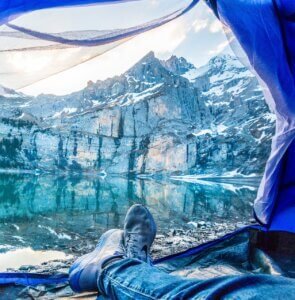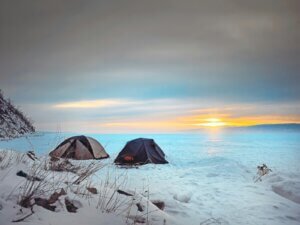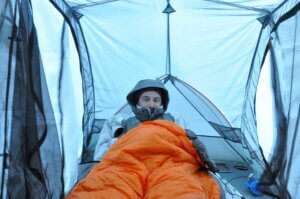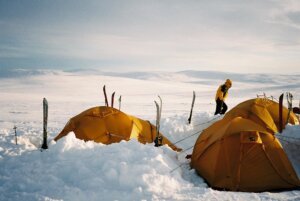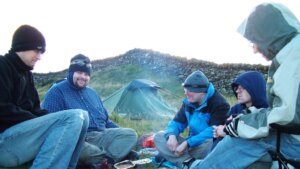Are you planning a camping trip in cold weather and wondering how to stay warm? In this article, we will provide you with some practical tips and tricks to keep yourself cozy and comfortable during your outdoor adventure. Whether you’re a seasoned camper or a beginner, these suggestions will help you enjoy your camping experience even in chilly temperatures. So put on your warmest hat and let’s dive into the world of camping in cold weather!
Layering Clothing
When camping in cold weather, it’s essential to layer your clothing properly to ensure maximum warmth and comfort. The key to effective layering is to choose the right base layer, add a middle layer for insulation, and use a waterproof and windproof outer layer.
Choose the right base layer
The base layer is the foundation of your clothing system, so it’s crucial to choose the right materials. Opt for moisture-wicking fabrics like merino wool or synthetic blends that will keep you dry by pulling sweat away from your body. These fabrics also provide insulation and help regulate body temperature.
Add a middle layer for insulation
The middle layer is responsible for trapping heat and providing additional insulation. Fleece jackets and thermal tops are excellent choices for this layer, as they are lightweight, breathable, and offer excellent warmth. Consider adding a vest or down jacket for extra coziness on colder days.
Use a waterproof and windproof outer layer
The outer layer is your defense against the elements, so it’s vital to choose gear that is both waterproof and windproof. Look for jackets and pants made with waterproof membranes like Gore-Tex, as they will keep you dry in rainy or snowy conditions. Additionally, ensure that the outer layer allows for good breathability to prevent overheating.
Proper Sleeping Gear
Getting a good night’s sleep is crucial for an enjoyable camping experience, especially in cold weather. Investing in quality sleeping gear will not only keep you warm but also provide comfort and insulation.
Invest in a quality sleeping bag
A high-quality sleeping bag designed for cold weather is a must-have for camping in chilly temperatures. Look for a bag with a temperature rating suitable for the lowest expected temperatures during your trip. Down-filled bags are excellent at retaining heat, while synthetic filled bags are more resistant to moisture.
Use a sleeping pad or insulated mattress
Sleeping directly on the cold ground can quickly drain heat from your body. To combat this, use a sleeping pad or an insulated mattress underneath your sleeping bag. These provide a barrier between you and the ground, preventing heat loss and adding a layer of comfort.
Consider a hot water bottle or heated blanket
For added warmth and coziness, consider using a hot water bottle or a heated blanket inside your sleeping bag. Fill a water bottle with warm water before bed and place it inside a sock to prevent burns. Alternatively, heated blankets designed specifically for camping can provide consistent and gentle warmth throughout the night.
Create a Cozy Campsite
Creating a cozy campsite is essential for staying warm and comfortable during your camping trip. By following a few simple steps, you can ensure that your campsite is well-insulated and protected from the elements.
Set up a tent with good insulation
Invest in a tent specifically designed for cold weather camping. Look for tents with a sturdy frame and a double-walled construction, as these provide better insulation. Additionally, consider choosing a tent with a rainfly that extends close to the ground to keep cold air out and warm air in.
Use a tent footprint or groundsheet
Laying a tent footprint or groundsheet underneath your tent provides an extra layer of insulation and protection. These sheets are typically made of waterproof and durable materials and help prevent moisture from seeping into your tent. They also offer added warmth by acting as a barrier between you and the cold ground.
Create a windbreak around your campsite
Strong winds can quickly make a camping trip unbearable, so it’s essential to create a windbreak around your campsite. Position your tent behind natural windbreaks like trees or bushes. If no natural barriers are available, consider using tarps or windbreak walls to shield your campsite from gusts of wind.
Fuel Your Body
Fueling your body with the right food and drinks is crucial for maintaining warmth and energy during cold weather camping trips.
Eat high-calorie meals
Cold weather camping requires more energy expenditure to keep your body warm. Therefore, focus on eating high-calorie meals that provide ample nutrition and energy. Incorporate foods rich in healthy fats, proteins, and complex carbohydrates, such as nuts, dried fruits, whole grains, and lean proteins.
Stay hydrated
Even though it may not feel like it, your body still requires hydration during cold weather camping. Dehydration can increase the risk of hypothermia, so make sure to drink plenty of water throughout the day. Consider carrying an insulated water bottle to prevent your water from freezing.
Pack warming drinks and snacks
Warm drinks can provide instant comfort and help regulate your body temperature. Pack tea bags, instant coffee, or hot chocolate mix, and bring a thermos to keep them hot. Additionally, pack snacks like soup mixes, instant oatmeal, or energy bars that can be easily prepared and provide warmth from the inside out.
Stay Active
Staying active during cold weather camping is an efficient way to generate body heat and keep warm throughout the day.
Keep moving during the day
Engage in various activities that keep your body moving, such as hiking, snowshoeing, or even exploring the campsite. Physical activity increases blood circulation, which helps keep your body warm. Remember to take breaks and rest when needed, but try to stay active for most of the day.
Exercise before bed
Before settling in for the night, engage in some light exercises or stretching inside your tent. This will help raise your core body temperature and promote better circulation, resulting in a warmer night’s sleep. Simple exercises like jumping jacks, lunges, or yoga poses can be done in a small space.
Use hand and foot warmers
Hand and foot warmers are compact heat sources that can provide instant warmth to chilly extremities. These small disposable packs can be easily activated and inserted into your gloves, socks, or pockets. By keeping your hands and feet warm, you’ll increase overall comfort and prevent discomfort caused by cold extremities.
Utilize Heat Sources
When temperatures drop, utilizing heat sources becomes essential for staying warm and comfortable during your camping trip.
Build a campfire
Building a campfire not only provides warmth but also creates a cozy and inviting atmosphere. Make sure to check local regulations and guidelines before starting a fire and follow proper safety precautions. A campfire can serve as a central heat source and a place to gather around and share stories while keeping warm.
Use a portable camping stove
A portable camping stove is a reliable heat source that provides warmth for cooking and boiling water. Many camping stoves are designed to be lightweight and compact, making them easy to transport. By utilizing a camping stove, you can prepare warm meals and beverages while maintaining a comfortable temperature at your campsite.
Bring a portable heater if allowed
Some camping areas allow the use of portable heaters. If permitted, consider bringing a portable heater specifically designed for outdoor use. These heaters usually operate on propane and can provide significant heat output, making them ideal for heating larger tent spaces. Always ensure proper ventilation and follow safety guidelines when using a portable heater.
Keep Your Extremities Warm
Extreme cold can quickly affect your extremities, so it’s crucial to provide adequate insulation and protection for your hands, feet, and head.
Wear warm socks and insulating footwear
Investing in high-quality, thermal socks is essential for keeping your feet warm. Look for socks made of merino wool or synthetic materials that provide excellent insulation and moisture-wicking properties. Pair your thermal socks with insulating footwear like winter boots that are waterproof and have a good grip to prevent slips on icy or snowy surfaces.
Invest in gloves or mittens
Protecting your hands is vital to maintaining dexterity and warmth. Invest in a good pair of gloves or mittens that are waterproof and insulated. Look for gloves or mittens with adjustable cuffs to prevent cold air from entering. Consider layering thin liner gloves underneath for extra warmth or using hand warmers inside your gloves.
Use a hat or beanie to retain heat
Heat escapes from our bodies through the head, so wearing a hat or beanie is essential for retaining warmth. Opt for hats made of insulating materials like fleece or wool, as they trap heat effectively. Ensure that the hat covers your ears and can be adjusted or tightened to fit snugly, preventing heat loss.
Stay Dry and Moisture-Free
Staying dry is critical to staying warm in cold weather camping conditions. Moisture can quickly sap body heat, leading to discomfort and even hypothermia.
Wear moisture-wicking and quick-drying clothing
Choosing clothing made of moisture-wicking and quick-drying materials is key to staying dry. Avoid cotton, as it retains moisture and takes a long time to dry. Instead, opt for synthetic fabrics or merino wool that can effectively move sweat away from your body and dry quickly. Layering with these materials will help keep you dry and warm.
Use waterproof gear and accessories
Ensure that all your gear, including your backpack, tent, and outer layers, are waterproof. Investing in quality waterproof gear will prevent rain or snow from seeping through and making you wet. Carry waterproof bags or stuff sacks to keep your belongings dry and protected from the elements.
Avoid excessive sweating
While physical activity is essential for staying warm, excessive sweating can lead to damp clothing and reduced insulation. Monitor your body temperature and layer up or remove layers accordingly to prevent overheating. Take breaks to cool down and remove any wet clothing immediately to prevent further heat loss.
Plan for a Warm Sleep
A good night’s sleep is crucial for camping enjoyment, especially when it’s cold outside. Proper preparation and strategies can make a significant difference in ensuring a warm and restful night.
Pre-warm your sleeping bag with a hot water bottle
Before climbing into your sleeping bag, pre-warm it by placing a hot water bottle inside for a few minutes. Ensure that the water bottle is wrapped in a sock or cloth to prevent burns. This simple technique will warm up your sleeping bag, making it more inviting and comfortable.
Change into dry clothes before bed
Before getting into your sleeping bag, change into dry clothes. Moisture trapped in your clothing will quickly drain heat from your body, resulting in discomfort and coldness. Wearing dry base layers and fresh socks will help retain warmth and improve overall comfort during the night.
Cover your head and neck to retain heat
When settling into your sleeping bag, make sure to cover your head and neck. These areas are particularly vulnerable to heat loss, so wearing a warm hat or using a neck gaiter will help retain precious warmth. A buff or a versatile headpiece can also be used to cover the mouth and nose, providing additional warmth and protection.
Emergency Preparedness
Even with careful planning, emergencies can happen during your camping trip. Being prepared with the right gear and knowledge can make a significant difference in ensuring your safety and well-being.
Pack emergency thermal blankets
Emergency thermal blankets, also known as space blankets, are lightweight and compact, making them easy to carry in your backpack. These blankets reflect body heat, providing crucial insulation in case of emergencies or unexpected temperature drops. Keep a couple of emergency blankets in your camping gear for added peace of mind.
Carry hand warmers and chemical heat packs
Hand warmers and chemical heat packs are excellent additions to your emergency kit. These small and portable heat sources can be activated easily and provide warmth for several hours. Keeping your hands and feet warm with hand warmers can prevent discomfort and maintain dexterity in cold weather conditions.
Have emergency contact and location information
Before embarking on your camping trip, ensure that you have emergency contact information easily accessible. Inform a trusted friend or family member about your intended location and expected return date. Carry a map and compass, or a GPS device, to avoid getting lost and to help rescuers find you in case of an emergency.
By following these tips and strategies, you can stay warm, comfortable, and safe during your camping adventures in cold weather. Remember to plan and prepare adequately, dress in appropriate layers, and stay nourished and hydrated. With the right gear, knowledge, and a positive attitude, you can enjoy a memorable and cozy camping experience, even in the chilliest temperatures.


